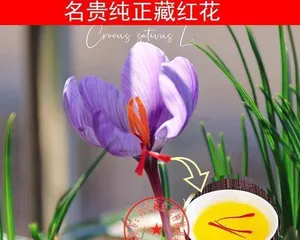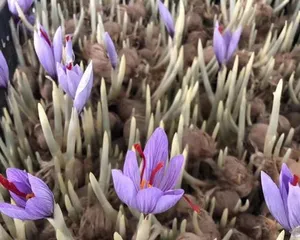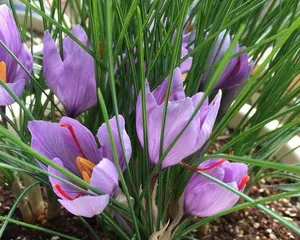Saffron is a vibrant flower often used to enhance the home atmosphere. However, due to its demanding growing conditions, it generally needs to be planted in a large area to grow well. Nevertheless, through container planting, we can also enjoy the beauty of saffron at home. This article will introduce how to grow saffron in containers at home, including variety selection, planting methods, and care techniques.

Variety Selection
Selecting the right saffron variety is one of the keys to successful container planting. Common saffron varieties on the market include Iranian saffron, Dutch saffron, and Spanish saffron. Among them, Dutch saffron grows quickly and produces numerous, plump flowers, making it a top choice for container planting.
Selecting the Right Container
Container planting of saffron requires a pot with moderate depth and good ventilation. It is recommended to choose ceramic or plastic pots, which are sturdy, of moderate weight, and not too heavy to move. At the same time, the bottom of the pot must have drainage holes to ensure adequate drainage.

Prepare Sufficient Soil
Before planting saffron in a container, sufficient soil needs to be prepared. It is recommended to use fertile, well-draining soil, and some well-rotted organic fertilizer can be added to improve soil fertility. At the same time, to prevent the soil from becoming too dry, some water-retaining agents can also be added.
Planting Method
First, fill the container with soil and compact the surface. Next, make several small holes in the soil, place the saffron corms in the holes, ensuring there is a proper distance between them. Then, cover the corms with a layer of soil and place the entire container in a well-lit, well-ventilated indoor location.
Light and Temperature
Saffron requires plenty of sunlight to grow and flower. It is recommended to place the container near a south, west, or southeast-facing window to ensure it receives at least 6 hours of direct sunlight daily. Additionally, the room temperature for the container-grown saffron should ideally be between 18-20°C.

Maintain Proper Humidity
Saffron likes a moist growing environment but does not like waterlogging. Therefore, when watering, pay attention to the amount, avoiding too much or too little. At the same time, to maintain proper humidity, you can spread moist plant ash or fine sand around the container.
Fertilize in a Timely Manner
During the growth of saffron, proper fertilization can improve its growth rate and flower quality. It is recommended to fertilize in spring and autumn, choosing fertilizers containing nutrients such as phosphorus and potassium.
Pruning and Post-Flowering Care
During the flowering period of saffron, regular pruning is necessary to maintain its beautiful shape. When pruning, be sure to keep the main stem and larger branches, and trim the branches into the desired shape. Post-flowering care is also very important; withered flowers should be removed in time to ensure the quality of the next flowering.
Pest and Disease Prevention
In the process of container planting saffron, you may encounter some pests and diseases. Common diseases include rot, mold, and aphids. To prevent pests and diseases, some insecticides and fungicides can be added to the soil.
Pay Attention to the Dormant Period
After the growing period, saffron will enter a dormant period. During the dormant period, watering and fertilization should be stopped, and the light intensity should be appropriately reduced to ensure its normal dormant state. After the dormant period, light and water can be gradually increased to stimulate saffron to enter a new round of growth.
Repot Regularly
During the container planting of saffron, the soil can easily deteriorate, so it needs to be repotted regularly. In general, repotting once a year is sufficient. When repotting, be sure to remove the old soil and trim any rotten or weak roots.
Clean the Leaf Surface Regularly
The leaves of saffron can easily absorb dust and bacteria, which will affect its normal growth after a long period of accumulation. Therefore, it is recommended to clean the leaves of saffron regularly with clean water or diluted fertilizer water to ensure its healthy growth.
Avoid Over-Drying
During the growth of saffron, a certain humidity needs to be maintained. However, in winter or when the temperature is low, indoor air can easily become too dry. To avoid over-drying, some humidity regulators can be added around the container, such as wet towels or wet sponges.
Prune Flower Stems in a Timely Manner
The flower stems of saffron can easily grow too long, affecting its beauty and growth rate during the growth process. Therefore, when the saffron stem reaches a certain length, it needs to be pruned in time. The part of the stem that is cut off should leave a length of 2-3 cm to protect the saffron corms.
Container planting of saffron requires attention to many aspects, including variety selection, container selection, soil preparation, planting methods, light and temperature, maintaining proper humidity, timely fertilization, pruning and post-flowering care, pest and disease prevention, paying attention to the dormant period, regular repotting, regular leaf surface cleaning, avoiding over-drying, and timely pruning of flower stems. Only by doing each part well can saffron grow well in containers at home and beautify the home environment.